Inside Apple Watch - battery, S1, Digital Crown and sensors making the Apple Watch tick
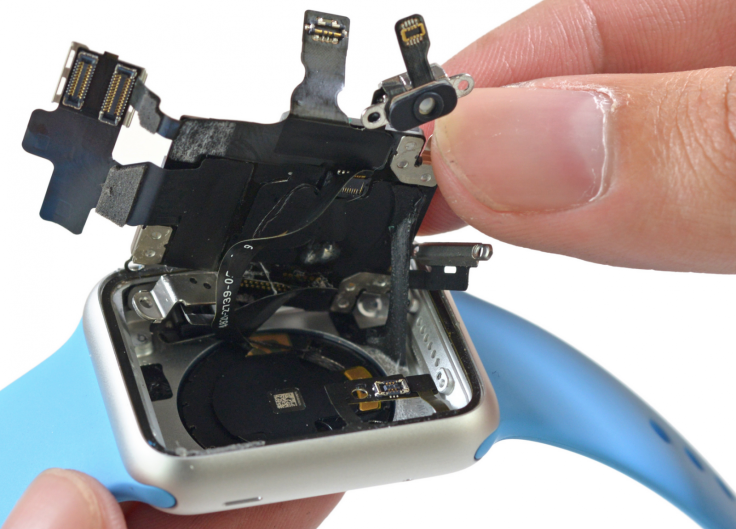
As Apple begins deliveries of its Watch to customers around the world, gadget repair company iFixit has already ripped the wearable apart to find out what lies within.
iFixit, which publishes repair guides and sells repair tools for Apple products like the iPhone, iPad and MacBook, travelled from its headquarters in the US to Melbourne in order to be among the first in the world to get their hands on the new smartwatch which began shipping on Friday (24 April) having gone on pre-order on 10 April.
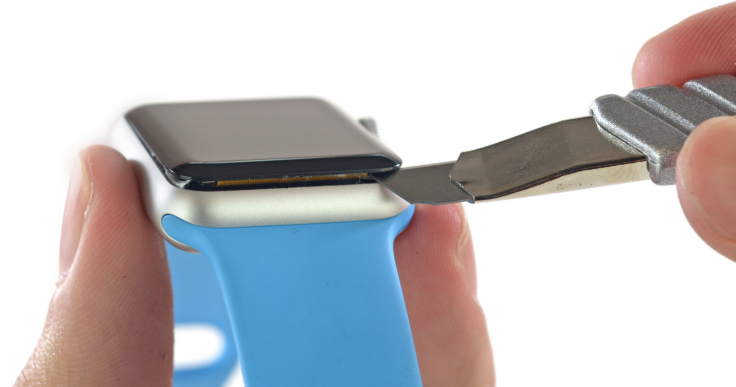
Having pried open the Apple Watch screen after applying a little heat, the company found a case packed with cables, sensors, chips and the battery.
Apple's Watch is powered by the bespoke S1 chip and while iFixit had been hoping to have a peek inside, the chip is entirely sealed in resin meaning iFixit has so far now been able to have a look inside.
Repairability
Many have questioned whether or not the Watch will be upgradeable as people typically keep watches for much longer than phones or tablets. The answer, according to iFixit, is no, as "the difficulty of removing the S1 alone casts serious doubt on the idea of simply swapping out the internals."
iFixit has given the Apple Watch a score of 5/10 Repairability Score, giving it plus points for the fact the watch band is easily removed and swapped; removing the screen is difficult but not impossible; and the battery is quite easy to remove.
On the negative side however iFixit says that removing any other component is "essentially impossible" as all peripheral cables are soldered onto the back of the S1 chip. And speaking of the S1, the fact it is encased in resin makes "board-level repairs impossible".
Below are some of the highlights of what you will find inside an Apple Watch:
- Blood-oxygen sensor - The Apple Watch has a heart rate sensor on the underside of the case, to allow you to monitor your heart rate and give more accurate activity tracking. However it looks like Apple is underplaying its hand here, as iFixit reveals the sensor is a "pulse oximeter" meaning that it can measure your blood oxygen level. So why isn't Apple claiming it can measure your blood oxygen level? iFixit suggests it is related to "FDA regulations and/or the inaccuracy and performance issues" which Apple states.
- Taptic Engine - Apple's attention to details in its products is renowned and this even goes as far as the innards of its products. The Taptic Engine in the Watch gets the Apple treatment with a tiny Apple logo imprinted on it. The Taptic Engine - which provides haptic feedback to the user through the screen - is attached to the speaker, which makes sense as when combined with "subtle audio cues from the specially engineered speaker driver, the Taptic Engine is designed to output a unique motion".
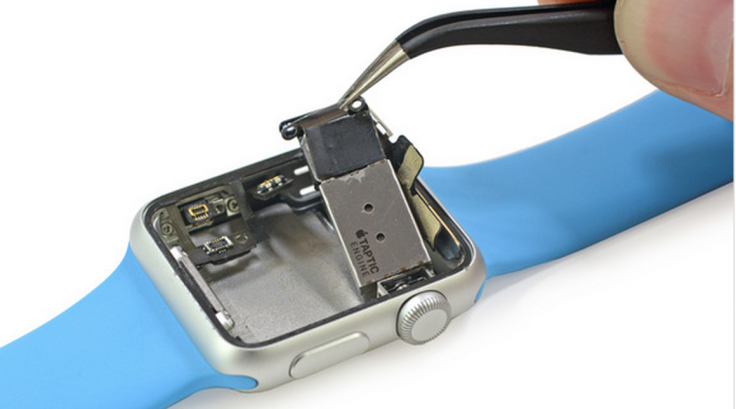
Speaker - Speaking of audio, the tiny speaker on the Apple Watch is fitted with an O-ring to aid water resistance with Apple getting an IPX7 rating for the Watch which means it can withstand up to 30 minutes of full submersion in up to 1 metre of water. However, iFixit warns: "These gaskets help, but rapid temperature changes will cause any metal to shrink or expand and can compromise the integrity of these seals."
- Diagnostic port - Apple has included a diagnostic port on one edge of the Watch to allow engineers diagnose issues with the device. iFixit confirms the presence of the port and on the inside (secured behind an enclosure with two tiny screws) they find "a set of contacts that align perfectly with the location of the hidden diagnostics port". What this port can be used for is still unknown however.
- Screws - The tri-wing screws used to secure components are among the smallest iFixit has ever encountered and even their smallest tools couldn't complete the job.
- Ambient light sensors - Unlike the ambient light sensors on smartphones and tablets, the sensor for the Watch is likely one of Apple's solar cell ambient light sensors, and "this allows for the sensor to be behind the display panel, as opposed to the traditional surface-mounted design seen on the majority of smartphones and tablets."
- Digital Crown - The Digital Crown is the name Apple gives to the dial on the side of the watch that acts like a scroll wheel and home button in one. iFixit has discovered that it seems to have an encoder system (like the Nest Thermostat) in order to read the spinning of the dial. As iFixit says "rotary encoders work by translating the angular position of a shaft into analog or digital code that computers can understand".
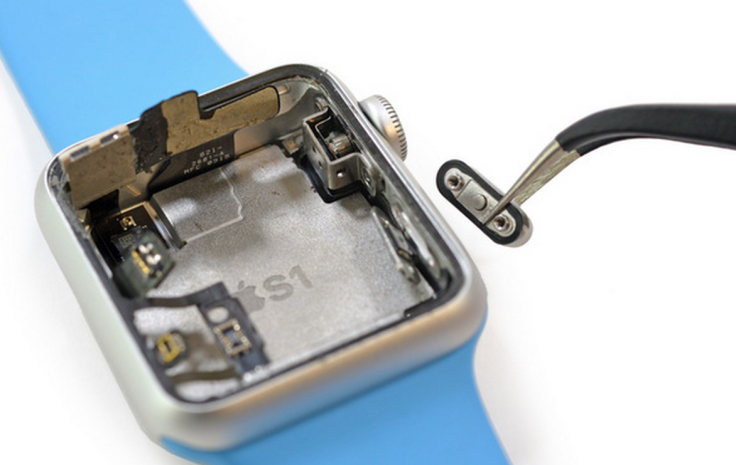
- iPhone for Ants? - Dubbed by iFixit as an iPhone for Ants, this tiny component (right) looks just like "a miniature version of an iPhone "which includes a button cable with a mechanical button" and the little button "even comes with a little button cover and gasket".
- Battery - As stated by Apple, the battery in the 38mm version of the Watch is a 205mAh lithium-ion model which Apple claims will give you up to 18 hours of life. The battery is not very securely attached, meaning it should be relatively easy to replace. Compared to the 300mAh batteries in the Moto 360 and Samsung Gear Live smartwatches however, it is pretty small.
- S1 chip - Having removed all the gubbins sitting on top of it, the iFixit engineers were disappointed to find they couldn't get access to the chip as it is "a solid block of plasticky resin, hiding treasures deep within". One of the commentators on the teardown however has this advice for getting a look inside the S1: "Probably have to boil it in Novec, followed by acid for several hours to reach the meat'n taters."
As well as looks at the hi-tech insides of Apple's wearable, iFixits decided to juxtapose the cutting edge technology with something a little bit older.
The image below show an Apple Watch side-by-side with the internal mechanic of a pocket watch mechanism built in the late 19th century.
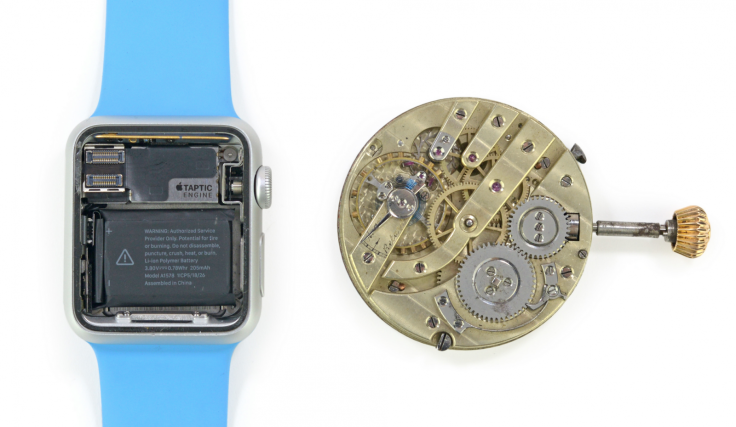
© Copyright IBTimes 2025. All rights reserved.






















